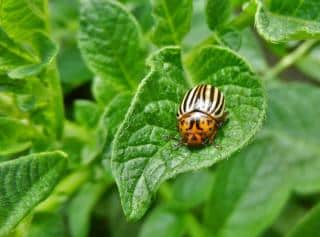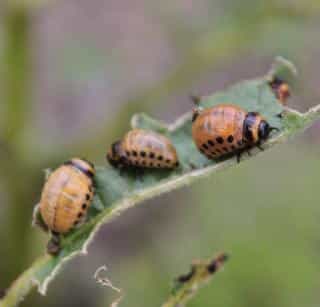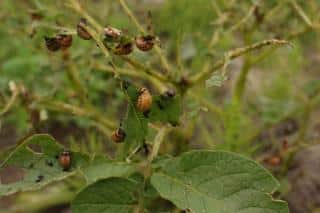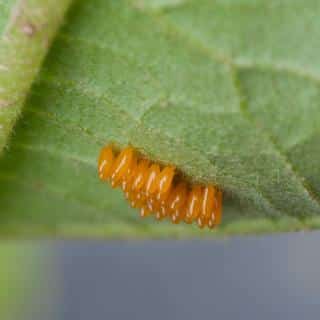These little striped beetles are definitely a hassle! The Colorado potato beetle devours leaves with terrifying speed! However, there are ways to fight against the potato bug which are fully natural and perfectly safe for the environment.
What is the potato beetle?
The potato beetle (or Colorado potato beetle, more specifically) is a vegetable patch pest that’s part of the beetle family, Coleoptera. Many fear it for its voracious appetite as it eats leaves off plants and destroys entire crops. In most of Europe, it was introduced accidentally and it doesn’t have many natural predators. Eliminating it is crucial whenever possible.
Identifying and recognizing a potato beetle
 Bright colors are what make the potato beetle easy to recognize. It looks like a large ladybug except that its back is striped with black and yellow stripes. About ½inch to ¾inch long (1 to 2 cm), it has a head, a thorax, and a brown abdomen. These contrasting colors frighten possible predators away, which makes it even more difficult to control. Larvae, on the other hand, aren’t as flashy. They’re humped, brown-orange in color, and have spots along the sides.
Bright colors are what make the potato beetle easy to recognize. It looks like a large ladybug except that its back is striped with black and yellow stripes. About ½inch to ¾inch long (1 to 2 cm), it has a head, a thorax, and a brown abdomen. These contrasting colors frighten possible predators away, which makes it even more difficult to control. Larvae, on the other hand, aren’t as flashy. They’re humped, brown-orange in color, and have spots along the sides.
- Good to know: potato beetle larvae are very similar to those of ladybugs! For ladybug larvae, the dots are on the back, not the sides. This helps tell the difference.
Lifecycle
The best way to get rid of these pests is get to know how they grow and multiply.
 Beginning of spring: potato beetles emerge from underground after hibernating. They start feeding on leaves
Beginning of spring: potato beetles emerge from underground after hibernating. They start feeding on leaves- During spring: females lay about 800 eggs each on the underside of leaves
- 2 weeks later, the larvae hatch and start feeding on the leaves
- They molt three times, then burrow underground for the last stage when they become a nymph.
- Adults emerge from the nymph, mate, and start laying a new batch of eggs
- At the end of summer, any remaining adults hide underground again to hibernate
An egg will reach the adult stage within 4 to 6 weeks. Simple math: every year, you’ll have 2 to 3 generations of beetles to deal with! This short, fast-paced lifecycle is what makes the Colorado beetle particularly difficult to eradicate.
Which plants does the potato beetle eat?
The potato beetle loves feeding on Solanaceae leaves. The potato plant is its favorite host! However, you will also certainly see some tomato, bell pepper or eggplant damage as well, this pest will travel all over the veggie patch.
→ Note: it also attacks sweet potato, but only as a second choice wherever nightshade plants are nearby.
How to fight off potato beetles?
Prevention
 Anticipating problems is the key to organic gardening! There are many ways to prevent problems, and you mightn’t even need to treat many diseases or fight against pests at all.
Anticipating problems is the key to organic gardening! There are many ways to prevent problems, and you mightn’t even need to treat many diseases or fight against pests at all.
- Crop rotation: this technique helps prevent diseases from settling in somewhere, and it also works to reduce the presence of pest insects from year to year. Avoid planting any plants of the Solanaceae family on the same plot two years in a row. This is even more so the case with the potato beetle which hibernates underground. If it doesn’t find any hosts when it wakes up, it’ll be easier to get rid of it!
- Companion planting: some plants will repel potato beetles, plant them near your potato plants! Typically, good examples of this are garlic, hemp, flax and castorbean.
- Stimulate the presence of ladybugs in the vegetable patch, they also eat potato bug eggs and larvae. Plants that attract ladybugs include nasturtium, fennel and broadbean.
Natural and organic treatment:
- If you’ve had potato beetles last year and you have chickens, go ahead and coral them in the vegetable patch at the end of winter, just before beetles emerge from their slumber. They’ll scour the entire patch, digging out any bugs and larvae that might be underground.
 Remove eggs manually, picking them off the underside of leaves wherever you find them. They’re quite easy to spot with their bright orange color once you turn a leaf over.
Remove eggs manually, picking them off the underside of leaves wherever you find them. They’re quite easy to spot with their bright orange color once you turn a leaf over.- One treatment that more and more gardeners recommend is Doryphora 30 CH. This is a homeopathic treatment that’s diluted in water (5 pellets in rainwater) and sprayed on leaves. Repeat daily until the beetles disappear.
- Spray horseradish or tansy fermented tea on the leaves of your Solanaceae plants.
- As a last recourse, but still an organic option, resort to a pyrethrum-based insecticide. First try the other methods out, because such insecticides, even natural ones, will kill off all insects: they won’t distinguish between pests and beneficial insects.
Images: CC BY 2.0: Dwight Sipler; Pixabay: Shannon Smith, Andrea Sternberg, Joaquin Saavedra Perez


 Bright colors are what make the potato beetle easy to recognize. It looks like a large ladybug except that its back is striped with black and yellow stripes. About ½inch to ¾inch long (1 to 2 cm), it has a head, a thorax, and a brown abdomen. These contrasting colors frighten possible predators away, which makes it even more difficult to control. Larvae, on the other hand, aren’t as flashy. They’re humped, brown-orange in color, and have spots along the sides.
Bright colors are what make the potato beetle easy to recognize. It looks like a large ladybug except that its back is striped with black and yellow stripes. About ½inch to ¾inch long (1 to 2 cm), it has a head, a thorax, and a brown abdomen. These contrasting colors frighten possible predators away, which makes it even more difficult to control. Larvae, on the other hand, aren’t as flashy. They’re humped, brown-orange in color, and have spots along the sides. Beginning of spring: potato beetles emerge from underground after hibernating. They start feeding on leaves
Beginning of spring: potato beetles emerge from underground after hibernating. They start feeding on leaves Anticipating problems is the key to organic gardening! There are many ways to prevent problems, and you mightn’t even need to treat many diseases or fight against pests at all.
Anticipating problems is the key to organic gardening! There are many ways to prevent problems, and you mightn’t even need to treat many diseases or fight against pests at all. Remove eggs manually, picking them off the underside of leaves wherever you find them. They’re quite easy to spot with their bright orange color once you turn a leaf over.
Remove eggs manually, picking them off the underside of leaves wherever you find them. They’re quite easy to spot with their bright orange color once you turn a leaf over.